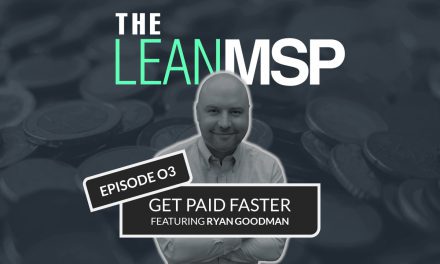Over the past year and a half, I had the opportunity to take a step back from the IT Channel, dedicating most of my time to deploying a custom enterprise app across the workforce of a globally recognized technology brand. Although that experience taught me a great deal, I could contend that my absence from the IT Channel taught me even more. The industry has undergone significant changes since I last left, and in certain areas, it may have veered off course.
To explain this unfortunate trend simply, I would say that the “rich have gotten richer and the poor have gotten poorer.” A lot of the exciting projects that were ramping up just a few years ago have now either died off completely, reached a point of stagnated support, or have been diluted by acquisitions from larger brands. While this is darwinism at its finest, and a part of the natural (often cruel) business cycle, that’s not to say that nothing should be done about it if it truly has a negative impact on MSPs. There are ways to tip this scale in a way that is in the best interests of the users and not the financiers that dominate the industry. This is what I hope to accomplish with this article and the many more on this topic that will come after.
What MSPs must realize is that their technology stack is precious real estate to vendors (and their investors), and thus it is the principal place for us to exercise the little control that we have. Letting any one brand dominate your technology stack may be convenient from a vendor management perspective, but otherwise it is the equivalent of giving up this control entirely.
The best way that I can think of to keep the industry in-balance is to make sure we continue to allocate a responsible portion of our tech stacks to more niche, often MSP-derived products. To help our readers get a better pulse on this segment of the market, I talked to a handful of Founders to get their opinion on the advantages and disadvantages of using such products and what they have learned from being on both sides of these relationships:
Better Product Fit
Product fit is crucial when it comes to software. It doesn’t matter how experienced the Founders, how sophisticated the marketing, or how well-funded the company; if there is no genuine need for the product, it will likely fail. Based on my experience, attaining product fit requires a deep understanding of the customer. You must have personally experienced the pain, tirelessly searching for a solution, only to find yourself back at the drawing board, brainstorming your own way to solve the problem. There is no one more qualified to achieve product fit for a Managed Service Provider than another MSP themselves.
The process that I just described is exactly what Bobby Lind and his team went through before launching their own PSA, called Zest MSP [reader disclosure: I am a Shareholder and Advisor of this project]. When I asked Bobby about this process, he told me “we tried to follow best practices and use the well-known PSAs in the industry. They just didn’t work for us. We couldn’t believe how complicated it was to satisfy our very basic needs. We have always had the philosophy that service delivery and the reporting to measure it should be simple. Once we realized that nothing like this existed, we almost had no choice but to build it ourselves. After achieving the outcome we wanted with our own MSP, we decided to bring the product to market so other MSPs could experience this simplicity too.” The genesis of a product and the story that goes with it tells me more than any feature list ever could. Software built for purpose and not financial-gain will win almost every time, and that is exactly what we should be looking to add to our tech stacks.
The Ultimate Guide To Cash Flow For Managed Services
Sponsored by Alternative Payments & Zest
Partner-First Mentality
While software continues to eat the world and everything has to be “productized,” MSPs have always been the support layer that sits on top. They are the cushion that makes user adoption a more comfortable process (or even achievable at all in some cases). To be able to survive in this role, you have to really care about your end-users experience and the quality of support that you provide to them. This is why when an MSP brings their own product to market, where they may lack in development quality or experience, they tend to make up for in partner support. I recently caught up with John Harden, a former MSP and Founder of Saaslio (which was acquired by Auvik last year), to discuss this very topic:
“I still remember going out to the house of one of our earliest partners of Saaslio. It was early COVID, and all of the offices were closed, but we needed to whiteboard, and virtual wasn’t cutting it. So we set up a whiteboard in the yard against a tree and designed all of the business processes they had, and where our software could support them. That’s how important getting our partner’s buy-in and feedback was to us.”
While not every Founder is willing to make “house calls” like John did, the idea that a partner would even have direct access to the product Founder at all is a benefit in itself. Replicating a business process from one organization to another is challenging and software will only get you so far. This is where Founders need to put on their consulting hat and take it the rest of the way, and in the case of former MSPs, this hat is well-worn and suits them perfectly.
Stronger User Communities
The communities that surround a product can oftentimes be just as, if not more valuable than the organization developing the product itself. Strong communities of fans and/or power-users can fill the support gaps and help to mentor newcomers in an organic way. What I love about this is that community is the ultimate equalizer in the IT Channel. You don’t need to have a million dollar marketing budget to build a community. In fact, the best way to build one is to just roll up your sleeves and put in the work to accomplish the shared outcome that the group is looking to achieve, then help each member do the same. Eventually, others will step up to lead and carry on the tradition.
I have seen many vendors try and fail to build this type of community and what I have found is that those that are unsuccessful are quick to position themselves as experts, but are never visibly doing the work. They are also not willing to take on the group’s problems as their own, which is a key ingredient that simply cannot be overlooked. MSP Founders are usually the exception to this. They have typically done the work in their own MSP and are ready and willing to help others experience the same outcome.
I was curious if there is any social proof to this observation, so I reached out to ecosystem expert and Co-Founder of Channel Program, Matt Solomon. His thoughts were that “from collecting thousands of partner reviews, we have found that in some categories, smaller vendors tend to get better reviews. I believe this is because they are laser-focused on the MSP experience (many being former MSPs themselves) and this ability to relate to their partners helps them develop more tight-knit communities around their brand. The strength of these partner communities offers some incredible advantages that are difficult for large vendors to recreate.”
Supports Innovation
While some might say that the IT Industry has reached a new level of maturity, we must remember that there is a slippery slope between “mature” and “antiquated.” Some of the most successful vendors that were first-to-market in the early 2000s, now find themselves in positions of power, exercising this every chance they get in the form of M&A activity. While this is good for entrepreneurs who are building SaaS products for the channel, too much consolidation is bad for MSPs. Not only does it limit the freedom of choice in our tech stacks, but it also leaves us with solutions that have been stitched together via acquisition, as opposed to well-thought out and native solutions that are developed in-house. Also, in an environment of heavy-handed consolidation at the top, we need more products at the bottom to fill the pipeline and keep the industry moving forward..
This poses the question, would these companies be able to survive at all without acquiring in lieu of ingenuity? I recently had a conversation with Jason Slagle, President of CNWR IT Consultants to discuss this, as well as the general state of innovation in the IT Channel. This is what he had to say on the subject:
“I think the big players are largely playing copycat on innovation. It seems like they’re too busy shoring up legacy dinosaur tech stacks, trying to stay competitive by purchasing or copying existing solutions on the market.” Slagle also echoed a similar sentiment in a recent reddit post, where he sounded off regarding the actions of one vendor who allegedly copied the MSP-developed and open-source M365 Management portal, CIPP. When I asked Jason about the importance of supporting such projects directly, he went on to say, “I’d love to see more open-source in our space like CIPP. While I understand not every MSP has the skills required to build software, they do have the ability to offer financial support for products that solve their needs in an open-source way. A project of this model is less likely to sell and exit.” He is definitely right in this regard, as there could be far more open-sourcing in the industry. This would still foster innovation, but do so without adding to the consolidation. It is my hope that the success of Kelvin Tegelaar’s CIPP acts as a case study for what is possible when taking this route to market.
The Ultimate Guide To Cash Flow For Managed Services
Sponsored by Alternative Payments & Zest
Counter-Arguments & Risks
While I am clearly an advocate for MSP-led SaaS products, it would be intellectually dishonest to say that there are no trade-offs required in adopting them. In fact, I talked to several people throughout the channel that had some insightful perspectives which contradicted my sentiment entirely. Among some of the most notable risks that were mentioned, were the lack of security, compliance and development strength of MSPs turned software entrepreneurs. Alex Farling of Lifecycle Insights (a former MSP himself) emphasized these points specifically and how critical they were in his own journey of launching a product, which would eventually be acquired by Scalepad earlier this year. These are all very valid arguments, and are applicable when dealing with almost any startup or early stage software provider, not necessarily only those founded by MSPs.
Another interesting counterpoint mentioned was that of poor performance. Founder of K7 Leadership, Kyle Christensen pointed out that: “It’s important for MSPs to realize that they can’t always tool their way out of a problem and in many cases new tools just create new distractions. These choices should come down to your growth objectives. If you start by defining what success looks like, you will be able to better decide if such tools are even necessary for you to accomplish your goals. If they are, then it is also important to measure either your time-to-ROI or time-to-implementation, depending on which metric best suits your desired outcome.”
How To Support
I understand that in many cases, trying to change out components of your tech stack while running your business is a lot like giving your car a tune-up while driving. It’s not easy, which leads a lot of MSPs to become complacent in vendor relationships that are no longer beneficial to them. For all these reasons, I am not expecting MSPs to read this and suddenly gut their entire tech stacks overnight in favor of newly found products. That’s not the point. The point is, that there are a lot of ways that MSPs can lend support and give these projects a fighting chance with little to no risk to them. Here are a few:
Demos & Feedback
One thing that I have learned from my involvement in Zest MSP is that some of the most productive demos are actually from MSPs that choose NOT to use the product. Whenever you find a prospect that is not a fit, you take a long look in the mirror and ask yourself, “are they the wrong type of customer or does the product lack key features necessary for mass adoption?” If you are an MSP that wants to show support without fully committing, offering your time to demo the product and provide feedback is a great way to gain product knowledge and contribute positively at the same time.
Community Engagement
After you have demoed a product and met the team, you likely have a better understanding if the solution will bring value to the industry or not. If you do find yourself intrigued enough to follow-along, consider showing support via engagement on Reddit, LinkedIn, Twitter and other social platforms whenever appropriate. Participating in a particular vendor’s community is always free and provides value in multiple ways.
Introductions & Referrals
Whether you choose to use the product or not, if you are part of a vendor’s greater community and are getting value from that participation, you likely have a good pulse on how the product is positively impacting those that are using it. If you do feel compelled to at this point, introducing the product and / or their Founders to members of your peer groups and communities may be beneficial to everyone involved and is another great way to lend support.
The Ultimate Guide To Cash Flow For Managed Services
Sponsored by Alternative Payments & Zest
List of MSP-Led Product Vendors
If you are ready and willing to support the cause, here are a few of the product vendors that I have identified as having been founded by former MSPs (validated via LinkedIn profiles and my general definition of what an MSP is).
- Zest MSP – A PSA built for MSPs, by an MSP
- Immybot – Workstation Setup & Deployment Tool
- Tribu – AI Automation for IT Helpdesk
- CyberQP – Access Management For MSPs
- Pia – Intelligent Automation for IT Service Desk
- bvoip – Cloud Unified Communications
- SaaS Alerts – Automated SaaS Security
- Compliance Risk – Compliance-as-a-Service
- OITVoIP – Service First Telecom & Distributed Networking
- Saaslio (post-acquisition) – SaaS Discovery For MSPs
- Lifecycle Insights (post-acquisition) – Asset Insight Reporting
- CIPP (open source) – Improved Partner Portal For M365
- TMinus365 (open source) – Microsoft Incentives Reporting
- Salesbuildr – Quoting & Self-service Storefront for MSPs
- Bizzity – Sales process automation for MSPs
- Nerdio – Microsoft Virtual Desktop Deployment
I am sure that I am missing a lot of names, so if you would like to suggest a vendor to be added to this list, please don’t hesitate to reach out to me via LinkedIn. Please include the product website as well as the profiles of the MSP Founders in your message. As this list grows, I hope to relocate it somewhere that will be more static and readily available.

SPONSORED BY ZEST

















